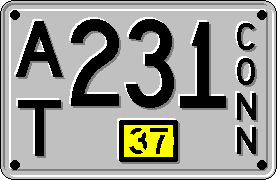
A in displaying an Ohio Bicentennial passenger plate. From 1935 through 1979, serials were allocated in blocks to each of the state's 88 counties. Serials were originally up to five characters in length and featured one or two letters. Increased demand resulted in the introduction of six-character serials in 1949, followed by all-numeric serials in 1962. The scheme was finally abandoned in 1980. Since 1983, plates have carried the county of issuance on a sticker.
Originally, this was a long sticker centered at the bottom of the plate, displaying the county name. In 1992, the state introduced a numerical county-coding scheme (see the County Coding section below), with the county number being displayed on a red sticker at the bottom left corner of the plate; this scheme was initially used only on specialty plates before being adopted on standard passenger plates when the Bicentennial base was introduced in October 2001.
License Plate Sticker Colors, Part 3: 1998-present. These tables summarize the colors of validation stickers used on passenger-car, light truck, and motorcycle. It was too late.
In 1956, the United States, Canada and Mexico came to an agreement with the, the and the that standardized the size for license plates for vehicles (except those for ) at 6 inches (15 cm) in height by 12 inches (30 cm) in width, with standardized mounting holes. The 1956 (dated 1957) issue was the first Ohio license plate that fully complied with these standards: the state had been issuing plates 6 inches in height by 12 inches in width since 1926, and all plates of the 1952 (dated 1953) and 1955 (dated 1956) issues were to these dimensions, but none had had standard mounting holes. In 1967, the state began issuing special plates to offenders with limited driving privileges. Judges in Ohio, however, rarely issued them until a 2004 state law made it mandatory for all DUI offenders with limited driving privileges to have them.
Non-passenger plates [ ] Image Type Dates issued Design Serial format Serials issued Notes Motorcycle 2004–10 Similar to 'Sunburst' passenger base 12ABC 01HHA to 99QOZ; 01RXD to 99TID 'Z' series used on Veteran Motorcycle plates. • • • • • • • • • • • • • • • • • • • • • • • • • • • • • • • • • • • • • • • • • • • • • • • • • • • • • • • • • • • • • • • • • • • • • • • • • • • • • • • • • • • • • • • • As of August 6, 2018, Ohio has returned to the original 'COUNTY NAME' at the bottom center of plates in place of the numbers.
The new stickers are black letters on white background and contain the 'OH' hologram when exposed at certain angles. County numbers are still being issued for Specialized Interest Plates, as the new stickers would cover up the slogan on Organizational Plates (i.e. 'Wildlife'.) Reserved series [ ] On recent seven-character baseplates, the state has reserved certain letter series to be issued in coordination with specific or leasing agencies. Ohio Bureau of Motor Vehicles. Archived from on October 10, 2012. Retrieved August 15, 2012.
• ^ Blackwell, Brandon (January 29, 2013).. Retrieved September 8, 2013. • ^ Nicholson, David (June 15, 2013).
Retrieved September 8, 2013. • ^ Luce, Lacey (November 28, 2011).. Archived from on September 22, 2012. Retrieved September 30, 2012. • ^ Taylor, Eric Robert (January 20, 2013).
Retrieved September 9, 2013. Download game point blank garena untuk laptop dan komputery. • (Press release). Bureau of Motor Vehicles,. August 12, 2003.
Archived from on December 2, 2003. Retrieved December 2, 2009. • ^ Pulfer, Mike (June 3, 2002)..
Retrieved September 8, 2013. June 7, 2010. Retrieved September 5, 2013. • ^ McNair, James (July 31, 2013).. Archived from on December 8, 2015. Retrieved September 5, 2013.

• ^ Tanner, Eric N. Retrieved September 10, 2013. • ^ Raiche, Steve. Retrieved May 21, 2017. Archived from on July 14, 2014. Retrieved September 8, 2013. Best of talking heads rare.
Ohio Bureau of Motor Vehicles. Retrieved September 9, 2013. The Horseless Age. Horseless Age Company. May 20, 1908. Under the new Ward automobile law, which has recently passed into effect in Ohio, the cities cannot license automobiles, and lose thereby a substantial income, Cincinnati, for instance, about $5,000 a year.